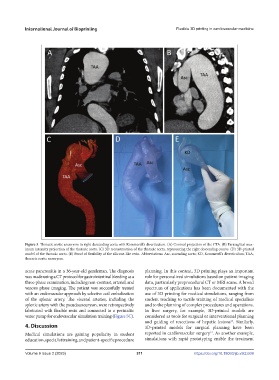Page 319 - IJB-9-2
P. 319
International Journal of Bioprinting Flexible 3D printing in cardiovascular medicine
Figure 3. Thoracic aortic aneurysm in right descending aorta with Kommerell’s diverticulum. (A) Coronal projection of the CTA. (B) Parasagittal max-
imum intensity projection of the thoracic aorta. (C) 3D reconstruction of the thoracic aorta, representing the right descending course. (D) 3D-printed
model of the thoracic aorta. (E) Proof of flexibility of the silicone-like resin. Abbreviations: Asc, ascending aorta; KD, Kommerell’s diverticulum; TAA,
thoracic aortic aneurysm.
acute pancreatitis in a 36-year-old gentleman. The diagnosis planning. In this context, 3D printing plays an important
was made using a CT protocol for gastrointestinal bleeding as a role for personalized simulations based on patient imaging
three-phase examination, including non-contrast, arterial, and data, particularly preprocedural CT or MRI scans. A broad
venous phase imaging. The patient was successfully treated spectrum of applications has been documented with the
with an endovascular approach by selective coil embolization use of 3D printing for medical simulations, ranging from
of the splenic artery. The visceral arteries, including the student teaching to tactile training of medical specialists
splenic artery with the pseudoaneurysm, were retrospectively and to the planning of complex procedures and operations.
fabricated with flexible resin and connected to a peristaltic In liver surgery, for example, 3D-printed models are
water pump for endovascular simulation training (Figure 5C). considered as tools for surgical or interventional planning
and guiding of resections of hepatic lesions . Similarly,
13
4. Discussion 3D-printed models for surgical planning have been
14
Medical simulations are gaining popularity in student reported in cardiovascular surgery . As another example,
education, specialist training, and patient-specific procedure simulations with rapid prototyping enable the treatment
Volume 9 Issue 2 (2023) 311 https://doi.org/10.18063/ijb.v9i2.669

